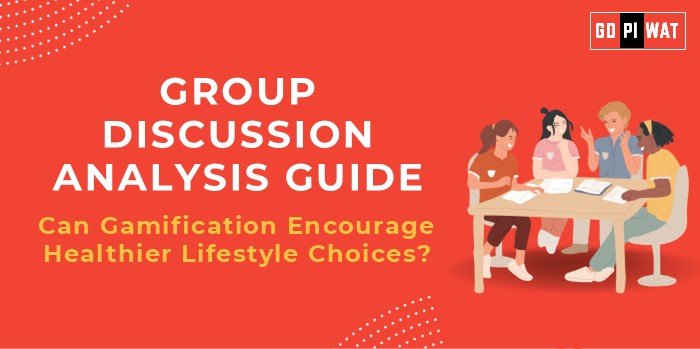📋 Group Discussion (GD) Analysis Guide: Can Gamification Encourage Healthier Lifestyle Choices?
🌐 Introduction to the Topic
Opening Context: Gamification is becoming a game-changer in promoting health and wellness, using elements of game design like points, rewards, and competition to foster engagement in fitness, nutrition, and mental well-being initiatives.
Topic Background: First introduced in the early 2000s, gamification integrates behavioral psychology and technology. It is now a $12 billion industry globally, revolutionizing sectors from healthcare to education. Recent trends, like fitness apps and wearable devices, spotlight its potential to combat global health challenges like obesity and inactivity.
📊 Quick Facts and Key Statistics
– 🏃 WHO Estimate on Physical Inactivity: 27.5% of adults worldwide do not meet recommended activity levels.
– 📱 Impact of Gamified Apps: Fitbit users logged 6.4 million steps/day on average, a 43% increase compared to baseline.
– 💰 Healthcare Costs: Lifestyle diseases account for 60% of global healthcare expenditure. Gamification may reduce these costs.
🤝 Stakeholders and Their Roles
- 💻 Technology Companies: Design and market gamified apps.
- 🏥 Healthcare Providers: Integrate gamification into patient care for better adherence.
- 🏛️ Policy Makers: Support initiatives that gamify public health campaigns.
- 👥 End Users: Individuals benefit directly through improved lifestyle habits.
🏆 Achievements and Challenges
✨ Achievements
- ✅ Behavioral Impact: Increased physical activity among users of gamified fitness apps by 30%.
- 📈 Healthcare Integration: Gamified mental health apps like Headspace and Calm help users reduce stress by 25%.
- 🤝 Community Engagement: Initiatives like “Step Challenges” foster collective accountability.
⚠️ Challenges
- 🌐 Digital Divide: Limited access in rural or underserved regions.
- 📉 Sustainability: User engagement often declines after the novelty wears off.
- 🔐 Data Privacy: Concerns over how health data is shared and stored.
🌍 Global Comparisons
- 🇯🇵 Japan: Uses gamification in public health policies like walking rewards systems.
- 🇺🇸 United States: Companies like Noom successfully integrate gamification into weight loss programs.
💡 Case Studies
- 🇮🇳 India: Zomato Fit recognized for incentivizing healthy eating by offering discounts for choosing healthier options.
💬 Structured Arguments for Discussion
Supporting Stance: “Gamification has transformed fitness by leveraging intrinsic and extrinsic motivation, evidenced by the rise in user engagement with apps like Fitbit and Strava.”
Opposing Stance: “While promising, gamification often fails to sustain long-term behavioral change, especially among underserved populations without access to technology.”
Balanced Perspective: “Gamification is a powerful tool, but its success depends on addressing barriers like accessibility and user retention.”
📚 Effective Discussion Approaches
- 📊 Opening Approaches:
- 📈 Start with a Statistic: “With 27.5% of adults globally inactive, gamification offers a scalable solution to inspire healthier habits.”
- 💬 Quote or Case Study: “As Mark Twain said, ‘The secret of getting ahead is getting started,’ a principle gamification effectively applies to health.”
- 🤝 Counter-Argument Handling:
- ✅ Use Evidence: Programs with regular content updates see a 40% retention boost.
🔍 Strategic Analysis of Strengths and Weaknesses
– ⚠️ Weaknesses: Engagement drops without continual innovation.
– 🌟 Opportunities: Expand into mental health and senior wellness.
– ⚠️ Threats: Risk of data misuse and ethical concerns.
📈 Connecting with B-School Applications
- 🌍 Real-World Applications: Explore gamification in healthtech startups or CSR initiatives to incentivize employee wellness.
- ❓ Sample Interview Questions:
- 💬 “How can gamification overcome the digital divide in developing nations?”
- 💡 “What role can wearable technology play in gamification for health?”
- 📖 Insights for Students:
- Develop a critical understanding of behavioral psychology.
- Explore collaboration opportunities between tech and healthcare.


